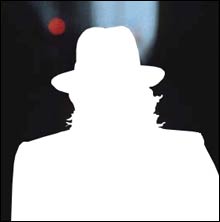 The 8”-by-10” photograph was hard to miss. Appearing on page A-3 of the Sunday New York Times on March 19, the black-and-white image of Erno Nussenzweig — a retired New Jersey diamond merchant and a member of the orthodox-Jewish Hasidic sect — stared out at readers just cracking open the morning paper. Taken in Times Square in 1999 by artist Philip-Lorca diCorcia, the picture hung in a well-received 2002 exhibition of diCorcia’s work at Chelsea’s Pace/MacGill Gallery, and it appears in the show’s exhibition catalogue. Nussenzweig, however, was not pleased with this notoriety: like virtually all ultra-orthodox Jews, he embraces the biblical injunction against “graven images.” And so Nussenzweig brought to the New York courts a legal challenge against such types of “street photography,” alleging that his privacy was violated when diCorcia snapped his picture and the gallery and catalogue displayed it. The Times chose to run the picture yet again — indeed, millions of times — to accompany its March 19 story on the lawsuit. This, from the same paper that elected — allegedly out of respect for Muslim sensitivities — not to republish any of the satirical Danish cartoons of Mohammed that caused an international uproar just last month. As Dorothy Parker might have said, “What fresh hell is this?”
The 8”-by-10” photograph was hard to miss. Appearing on page A-3 of the Sunday New York Times on March 19, the black-and-white image of Erno Nussenzweig — a retired New Jersey diamond merchant and a member of the orthodox-Jewish Hasidic sect — stared out at readers just cracking open the morning paper. Taken in Times Square in 1999 by artist Philip-Lorca diCorcia, the picture hung in a well-received 2002 exhibition of diCorcia’s work at Chelsea’s Pace/MacGill Gallery, and it appears in the show’s exhibition catalogue. Nussenzweig, however, was not pleased with this notoriety: like virtually all ultra-orthodox Jews, he embraces the biblical injunction against “graven images.” And so Nussenzweig brought to the New York courts a legal challenge against such types of “street photography,” alleging that his privacy was violated when diCorcia snapped his picture and the gallery and catalogue displayed it. The Times chose to run the picture yet again — indeed, millions of times — to accompany its March 19 story on the lawsuit. This, from the same paper that elected — allegedly out of respect for Muslim sensitivities — not to republish any of the satirical Danish cartoons of Mohammed that caused an international uproar just last month. As Dorothy Parker might have said, “What fresh hell is this?”
On February 7, Times editor Bill Keller told USA Today that publishing the Mohammed cartoons would be “perceived as a particularly deliberate insult” by Muslims, and that, moreover, not publishing them “feels like the right thing to do.” A Times staff editorial published the same day similarly intoned that the Times’ refusal to publish the Mohammed cartoons “seems a reasonable choice for news organizations that usually refrain from gratuitous assaults on religious symbols, especially since the cartoons are so easy to describe in words.”

So why publish something offensive to Jews — and, especially, to the orthodox Jew who was the unwitting and unwilling subject of the photograph — while refusing to publish something offensive to Muslims? It can’t be that the publication of Nussenzweig’s image isn’t sacrilegious. The same injunction against graven images causes observant Jehovah’s Witnesses to refuse to pledge allegiance to the flag. For that matter, it also caused Muslims around the world to protest the depiction of their prophet in the now-famous cartoons. It’s true that the greatest offense was given by the several that depicted Mohammed as a terrorist, yet the underlying prohibition against any depiction remains the same across the board.
The insult is all the greater, in this instance, because the harm was so easily avoided. Last Sunday’s Times article covered two other examples of “street photography” by famed portraitists, and the exhibition catalogue contained many other diCorcia street portraits, so diCorcia’s Nussenzweig picture was hardly needed to illustrate the genre.
Nor is it that the Mohammed cartoons are any less newsworthy than the image of Nussenzweig. Compared with any number of ways the Times’ editors could have illustrated its story on Nussenzweig’s lawsuit, the newsworthiness of those particular Mohammed cartoons is without question. As Greg Lukianoff, president of the Foundation for Individual Rights in Education (disclosure: on whose board I serve), has noted, these “cartoons are almost certainly the most relevant and newsworthy cartoons in history. One would be hard-pressed to come up with other cartoons or even images that have resulted in so much controversy, death, and international strife.”
Nussenzweig’s civil suit was properly dismissed last month on First Amendment grounds, since a citizen in a free society must be prepared to give up some privacy while walking on a public street. But the fact that the Times had the constitutional right to publish did not require the newspaper to deviate from what its editorial referred to as its policy of avoiding “gratuitous assaults on religious symbols.”
When the Boston Phoenix decided not to republish the cartoons, it admitted candidly that it was taking that highly unusual (for this paper) step out of fear of provoking violence against its staff (see Editorial, News and Features, February 10). Either the Times engages in a double standard as to whom it will or will not insult gratuitously, or it has been less than candid about the real reason it refrained from publishing the cartoons.